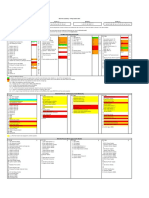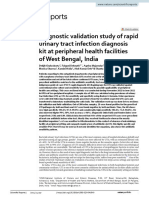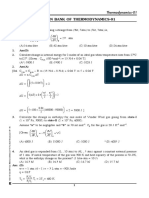CH08
CH08
Uploaded by
Dessyta miranda SCopyright:
Available Formats
CH08
CH08
Uploaded by
Dessyta miranda SCopyright
Available Formats
Share this document
Did you find this document useful?
Is this content inappropriate?
Copyright:
Available Formats
CH08
CH08
Uploaded by
Dessyta miranda SCopyright:
Available Formats
Chapter 8
Data Collection Methods
© 2009 John Wiley & Sons Ltd. 1
www.wileyeurope.com/college/sekaran
Sources of Data
Primary data: information obtained firsthand by the researcher on
the variables of interest for the specific purpose of the study.
Examples: individuals, focus groups, panels
Secondary data: information gathered from sources already
existing.
Examples: company records or archives, government
publications, industry analyses offered by the media, web sites,
the Internet, and so on.
© 2009 John Wiley & Sons Ltd. 2
www.wileyeurope.com/college/sekaran
Personal Interview
Advantages
– Can clarify doubts about questionnaire
– Can pick up non-verbal cues
– Relatively high response/cooperation
– Special visual aids and scoring devises can be used
Disadvantages
– High costs and time intensive
– Geographical limitations
– Response bias / Confidentiality difficult to be assured
– Some respondents are unwilling to talk to strangers
– Trained interviewers
© 2009 John Wiley & Sons Ltd. 3
www.wileyeurope.com/college/sekaran
Telephone Interview
Advantages
– Discomfort of face to face is avoided
– Faster / Number of calls per day could be high
– Lower cost
Disadvantages
– Interview length must be limited
– Low response rate
– No facial expressions
© 2009 John Wiley & Sons Ltd. 4
www.wileyeurope.com/college/sekaran
Self-administered
Advantages
– Lowest cost option
– Expanded geographical coverage
– Requires minimal staff
– Perceived as more anonymous
Disadvantages
– Low response rate in some modes
– No interviewer intervention possible for clarification
– Cannot be too long or complex
– Incomplete surveys
© 2009 John Wiley & Sons Ltd. 5
www.wileyeurope.com/college/sekaran
Principles of Questionnaire Design.
© 2009 John Wiley & Sons Ltd. 6
www.wileyeurope.com/college/sekaran
Questionnaire Design
Definition
A questionnaire is a pre-formulated, written set of questions to which
the respondent records his answers
Steps
1. Determine the content of the questionnaire
2. Determine the form of response
3. Determine the wording of the questions
4. Determine the question sequence
5. Write cover letter
© 2009 John Wiley & Sons Ltd. 7
www.wileyeurope.com/college/sekaran
1. Questionnaire content
Framework
Need information for all constructs in framework
Measurement: Operationalizing
– Objective construct:
• 1 element/items
=> 1 question
– Subjective construct:
• multiple elements/items
=> multiple questions
© 2009 John Wiley & Sons Ltd. 8
www.wileyeurope.com/college/sekaran
2. Response format
Closed vs. Open-ended questions
– Closed questions
• Helps respondents to make quick decisions
• Helps researchers to code
– Open-ended question
• First: unbiased point of view
• Final: additional insights
• Complementary to closed question: for interpretation purpose
Cfr. Measurement: Response scales
© 2009 John Wiley & Sons Ltd. 9
www.wileyeurope.com/college/sekaran
3. Question Wording
Avoid double-barreled questions
Avoid ambiguous questions and words
Use of ordinary words
Avoid leading or biasing questions
Social desirability
Avoid recall depended questions
© 2009 John Wiley & Sons Ltd. 10
www.wileyeurope.com/college/sekaran
Question Wording
Use positive and negative statements
– Dresdner delivers high quality banking service
Dresdner has poor customer operational support
– Avoid double negatives
Limit the length of the questions
Rules of thumb:
– < 20 words
– < one full line in print
© 2009 John Wiley & Sons Ltd. 11
www.wileyeurope.com/college/sekaran
4. Question Sequence
Personal and sensitive data at the end
© 2009 John Wiley & Sons Ltd. 12
www.wileyeurope.com/college/sekaran
5. Cover Letter
The cover letter is the introductory page of the
questionnaire
It includes:
– Identification of the researcher
– Motivation for respondents to fill it in
– Confidentiality
– Thanking of the respondent
© 2009 John Wiley & Sons Ltd. 13
www.wileyeurope.com/college/sekaran
Structured Observations
Recording prespecified behavioral patterns of people,
objects and events in a systematic manner.
Quantitative in nature
Different types
– Personal observation
(e.g., mystery shopper, pantry audit)
– Electronic observation
(e.g., scanner data, people meter, eye tracking)
© 2009 John Wiley & Sons Ltd. 14
www.wileyeurope.com/college/sekaran
You might also like
- Research Method Slides Chap 1-13 CompleteDocument186 pagesResearch Method Slides Chap 1-13 CompleteFauzan Usman83% (6)
- 118F 0000 ADocument606 pages118F 0000 AHarunFatoni100% (4)
- Jess2002 - Sugar Daddy Needed PDFDocument375 pagesJess2002 - Sugar Daddy Needed PDFShivani Malik100% (5)
- Data Collection Methods: © 2009 John Wiley & Sons LTDDocument14 pagesData Collection Methods: © 2009 John Wiley & Sons LTDsalma kavishe100% (1)
- CH08 Data Collection MethodsDocument14 pagesCH08 Data Collection MethodsMaliha NazarNo ratings yet
- RM CH4Document23 pagesRM CH4mzuodyNo ratings yet
- Chapter 8 Data CollectionDocument27 pagesChapter 8 Data CollectionHum92re100% (3)
- CH 09Document8 pagesCH 09abdelrahmanelnaggar743No ratings yet
- Ch09 Data Collection MethodsDocument8 pagesCh09 Data Collection MethodsGoranM.MuhammadNo ratings yet
- The Research Process: - Elements of Research DesignDocument10 pagesThe Research Process: - Elements of Research DesignNadiyah ShofwahNo ratings yet
- CH08 Data Collection Methods 2Document21 pagesCH08 Data Collection Methods 2Jaydee AliNo ratings yet
- Questionnaires Data Collection Methods QuestionnairesDocument21 pagesQuestionnaires Data Collection Methods QuestionnairesMd Hamid Ullah Bhuian 1310851630No ratings yet
- The Research Report: © 2009 John Wiley & Sons LTDDocument6 pagesThe Research Report: © 2009 John Wiley & Sons LTDmegaNo ratings yet
- SESI 8 Data Collection Methods QuestionairesDocument9 pagesSESI 8 Data Collection Methods QuestionairesStevia TjioeNo ratings yet
- Research Methods For Business - Ch07Document7 pagesResearch Methods For Business - Ch07Shahd Elshami100% (3)
- Elements of Research DesignDocument12 pagesElements of Research DesignShaon KhanNo ratings yet
- CH 06Document11 pagesCH 06abdelrahmanelnaggar743No ratings yet
- Introduction To Research: Research Methods Business Research Methods BusinessDocument15 pagesIntroduction To Research: Research Methods Business Research Methods BusinessNataliaNo ratings yet
- Bryman's Social Research Methods 6e: Chapter 11: Asking QuestionsDocument15 pagesBryman's Social Research Methods 6e: Chapter 11: Asking QuestionsYuni DfNo ratings yet
- Research Method Slides Chap 1 13 CompleteDocument186 pagesResearch Method Slides Chap 1 13 CompletesyedrazaaNo ratings yet
- Chapter 3Document14 pagesChapter 3Eslam SamyNo ratings yet
- 03 - Chapter 3Document14 pages03 - Chapter 3Mustafa MohammedNo ratings yet
- Research Methods For Business: A Skill-Building ApproachDocument21 pagesResearch Methods For Business: A Skill-Building ApproachJannah Mae NeneNo ratings yet
- CH 01Document10 pagesCH 01mohamedfilfilahmedNo ratings yet
- Scientific Investigation: © 2009 John Wiley & Sons LTDDocument11 pagesScientific Investigation: © 2009 John Wiley & Sons LTDAditya VarellaNo ratings yet
- The Broad Problem 3Document19 pagesThe Broad Problem 3Apef Yok0% (2)
- Introduction To Research-1Document8 pagesIntroduction To Research-1Shaon KhanNo ratings yet
- 02 - Chapter 2Document11 pages02 - Chapter 2Mustafa MohammedNo ratings yet
- Ch03 UMTDocument12 pagesCh03 UMTnsominvz345No ratings yet
- Measurement of Variables: Operational Definition: © 2009 John Wiley & Sons LTDDocument15 pagesMeasurement of Variables: Operational Definition: © 2009 John Wiley & Sons LTDsiti amiraNo ratings yet
- Scientific Investigation: Business BusinessDocument14 pagesScientific Investigation: Business BusinessadaNo ratings yet
- Scientific Investigation 1Document14 pagesScientific Investigation 1Shaon KhanNo ratings yet
- MMPC 05 EM Solved Assignment 2024 25 2qhfp2Document18 pagesMMPC 05 EM Solved Assignment 2024 25 2qhfp2Divyanshu YadavNo ratings yet
- 1research ProposalDocument21 pages1research ProposalAmal MobarakiNo ratings yet
- CH 03Document9 pagesCH 03Try Wasana SetyadiNo ratings yet
- Chapter 8 Questionnaire Design and Fieldwork PlanDocument26 pagesChapter 8 Questionnaire Design and Fieldwork PlanJhagantini PalaniveluNo ratings yet
- Data Collection MethodDocument37 pagesData Collection MethodLisa BaizuraNo ratings yet
- WK4-TMF1014-SEM1-2022-2023-LU4 Information GatheringDocument42 pagesWK4-TMF1014-SEM1-2022-2023-LU4 Information GatheringPC JeeNo ratings yet
- CH 13Document21 pagesCH 13Eriko Timothy Ginting100% (1)
- Introduction To Research The Research Process - The Broad ProblemDocument25 pagesIntroduction To Research The Research Process - The Broad ProblemGoranM.MuhammadNo ratings yet
- Essentials of Marketing Research: Part 3: Gathering and Collecting Accurate DataDocument24 pagesEssentials of Marketing Research: Part 3: Gathering and Collecting Accurate DatatssfzrNo ratings yet
- VCW Phase 2Document23 pagesVCW Phase 2nikolas85No ratings yet
- ACE313 Engineering Utilities 1: (Electrical Systems)Document22 pagesACE313 Engineering Utilities 1: (Electrical Systems)Kean Havan PingoyNo ratings yet
- Ch13 SamplingDocument20 pagesCh13 SamplingMd Hamid Ullah Bhuian 1310851630No ratings yet
- Essentials of Marketing ResearchDocument27 pagesEssentials of Marketing ResearchtssfzrNo ratings yet
- Data Collection Part 1Document57 pagesData Collection Part 1Reem AlmetramiNo ratings yet
- CH07 Measurement of Variables - Scaling, Reliability, ValidityDocument17 pagesCH07 Measurement of Variables - Scaling, Reliability, ValidityMaliha NazarNo ratings yet
- Communication MethodDocument30 pagesCommunication MethodMisganaw GishenNo ratings yet
- Sampling: Research Methods BusinessDocument19 pagesSampling: Research Methods BusinessAkib xabedNo ratings yet
- Data Collection MethodsDocument6 pagesData Collection MethodsKomal RahimNo ratings yet
- Chap008 UpdatedDocument17 pagesChap008 UpdatedTiến Bùi MinhNo ratings yet
- Quarter2-Module2 RevisedDocument9 pagesQuarter2-Module2 RevisedGino HotingoyNo ratings yet
- Collecting and Constructing DataDocument17 pagesCollecting and Constructing DataEdwin OkonNo ratings yet
- Chapter 5 Theoretical Framework and Hypothesis DevelopementDocument12 pagesChapter 5 Theoretical Framework and Hypothesis DevelopementSophia RusliNo ratings yet
- Human Computer InteractionDocument12 pagesHuman Computer InteractionUsmanHaiderNo ratings yet
- Interview and Observation 1Document29 pagesInterview and Observation 1Cheyenne NableaNo ratings yet
- SEM2 23-24 SeptF - HUM Wk2.3Document18 pagesSEM2 23-24 SeptF - HUM Wk2.3Minh TrangNo ratings yet
- Unit 2 Chapter 2.2Document32 pagesUnit 2 Chapter 2.2sodiumbromate3.14No ratings yet
- 200-Chapter-7,8 & 9Document75 pages200-Chapter-7,8 & 9Parth Chopra67% (3)
- Research Methods For Business: Administering QuestionnairesDocument31 pagesResearch Methods For Business: Administering QuestionnairesloubnaNo ratings yet
- Master IELTS Reading (General): Tips, Readings, and Practice QuestionsFrom EverandMaster IELTS Reading (General): Tips, Readings, and Practice QuestionsNo ratings yet
- Mastering Interviews: Secrets to Presenting Yourself Confidently Before EmployersFrom EverandMastering Interviews: Secrets to Presenting Yourself Confidently Before EmployersNo ratings yet
- Paulius Bogusevicius CV PDFDocument2 pagesPaulius Bogusevicius CV PDFPaulius BoguseviciusNo ratings yet
- Fire Drills ProceduresDocument2 pagesFire Drills ProceduresAnumolu Ramakrishna100% (1)
- Detailed Lesson Plan in ElectricalDocument7 pagesDetailed Lesson Plan in ElectricalJc Santos50% (2)
- Part-B-Ml-Ll Filipino 6Document4 pagesPart-B-Ml-Ll Filipino 6Liezel BersalesNo ratings yet
- 026 Republic vs. HidalgoDocument20 pages026 Republic vs. HidalgoRonald MorenoNo ratings yet
- Niengo Outsep North Papua 5 - 06 - 07rev2Document20 pagesNiengo Outsep North Papua 5 - 06 - 07rev2Prince DenhaagNo ratings yet
- STAR Anhydride Line Pipe High Pressure Standard Design Data SheetDocument4 pagesSTAR Anhydride Line Pipe High Pressure Standard Design Data SheetFirasNo ratings yet
- ECU Pinouts BC5 BG5a WRX (4 Plug) - Single SwapDocument1 pageECU Pinouts BC5 BG5a WRX (4 Plug) - Single SwapSajjad KhaliqNo ratings yet
- 2014 Winter Model Answer PaperDocument36 pages2014 Winter Model Answer PaperBharatNo ratings yet
- Digitization of Land RecordsDocument6 pagesDigitization of Land RecordsMuntazir AbbasNo ratings yet
- Bcom FcaDocument146 pagesBcom Fcavarsha102kadamNo ratings yet
- Past PaperDocument4 pagesPast PapermanulanilanthiNo ratings yet
- Tutorial 5.1Document3 pagesTutorial 5.1kavithma3085No ratings yet
- EMC For Systems and Installations - Part 1Document12 pagesEMC For Systems and Installations - Part 1mojingyan0% (1)
- SGT 600Document47 pagesSGT 600masoodkamaliNo ratings yet
- Philippine Organic Act of 1902Document44 pagesPhilippine Organic Act of 1902rixzylicoqui.salcedoNo ratings yet
- Lab4 VOIP CCNADocument21 pagesLab4 VOIP CCNAxml xmlNo ratings yet
- Art Collectoions 2021Document32 pagesArt Collectoions 2021HermanNo ratings yet
- Ashok-Kay (Kanagarajah) PDFDocument10 pagesAshok-Kay (Kanagarajah) PDFedue slipNo ratings yet
- High School Essay WritingDocument5 pagesHigh School Essay WritingafabkkkrbNo ratings yet
- 11 86 Me DTS 00008Document3 pages11 86 Me DTS 00008Erdal CanNo ratings yet
- Rapidogram Study 2024Document8 pagesRapidogram Study 2024Dinoop Korol PonnambathNo ratings yet
- Dark Activity Detection in AIS-Based Maritime NetworksDocument6 pagesDark Activity Detection in AIS-Based Maritime Networkskeshavarz.shirazu.ac.irNo ratings yet
- Epicor ERP Embedded Courses A4 FS ENSDocument2 pagesEpicor ERP Embedded Courses A4 FS ENSHuong NguyenNo ratings yet
- Plsqlparti 1Document19 pagesPlsqlparti 1RC LuckyNo ratings yet
- Roll Nos. of Candidates Shortlisted For The Interview For The Post of Assistants For Which Written Examination Was Held On April 29, 2012Document38 pagesRoll Nos. of Candidates Shortlisted For The Interview For The Post of Assistants For Which Written Examination Was Held On April 29, 2012Thomas SebastianNo ratings yet
- Lecture 3 - Reinforced Concrete Framed StructuresDocument18 pagesLecture 3 - Reinforced Concrete Framed StructuresYI HEN ONG100% (1)
- Thermodynamic 01Document5 pagesThermodynamic 01Tapan BadheiNo ratings yet

























































































